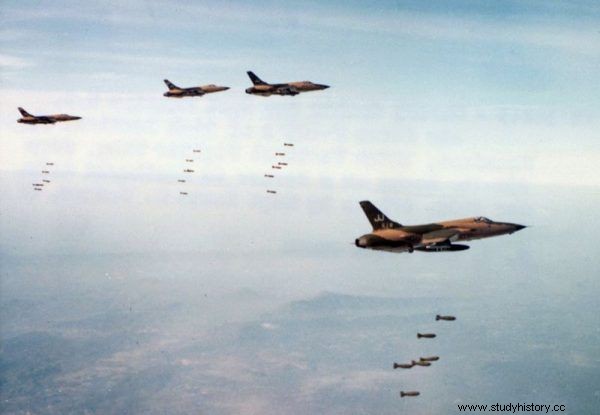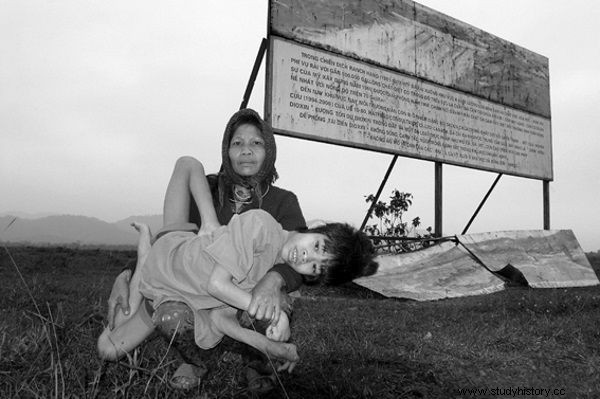Bombing of schools and hospitals. Use of chemical weapons against civilians. Massacres of defenseless villages. The American military intervention in Vietnam was conducted in the name of freedom, democracy, and other Western values, but the reality had little to do with it. What was this nightmare war really like?
When they began their intervention in Vietnam on a larger scale in 1964, the Americans did not realize what a hard war they would face. Confident in the numbers and modern equipment of their army, they expected that the suppression of the communist guerrillas, supported by North Vietnamese troops, would be quick and simple. It turned out, however, that fighting the troops supported by the local population is extremely difficult, and the seemingly banal conflict is not that easy to end.
Bombs on schools and hospitals
In this situation, the American command resorted to technical means. In 1965, an operation called "Rolling Thunder" began, ie the bombing of North Vietnam, as well as communist guerrilla bases in South Vietnam and their supply routes. More and more airplanes and bigger and bigger bombs were used to achieve their goals. Finally, the raids took on a massive character.
Initially, fighter-bomber machines participated in the actions, later light and heavy bombers were used, and finally - strategic Boeing B-52 Stratofortress bombers. In addition to air bombs, those penetrating the ground were dropped; Detonating missiles and banned cluster bombs were also used.
Air raids were made primarily on military bases, weapons depots and communication routes. Ordinary towns and villages sometimes became their targets. Residential houses, hospitals, schools and sanatoriums were bombed. These are the effects of a raid on one of the Vietnamese schools in February 1966 described by a twenty-four-year-old Thai teacher Van Nham:
Parts of clothes, books, furniture flew so high that everyone in the area knew that the school had been bombed. The students were torn to pieces. Many were covered with earth. […] The bodies of the children were sticking out of the ground. We found heads twenty yards away. The insides were scattered everywhere. [...] The children were pressed into the walls of the anti-aircraft ditch. The ditches were filled with blood. The children clutched their books to their chests, stained with blood and ink. Some could barely speak. Then blood spurted from their mouths. Died as a result of internal injuries .

About 1.6 million tons of bombs have been dropped on Vietnam.
There were more such murderous bombings. Rolling Thunder ran until 1968. During that time, the American air force made more than 200,000 flights and dropped 864,000 tons of bombs on the territory of North Vietnam, and 1.6 million tons - on the territory of the entire country. The raids killed around 90,000 Vietnamese. To this day, U.S. aerial bombs have been found in the areas affected by the operation, and accidental explosions continue to kill civilians, including children.
Burn the jungle, poison people
To deprive the communist guerrillas of a base of operations and shelter, American planners decided to destroy the Vietnamese jungle. For this purpose, carpet raids with the use of chemical weapons were launched. Napalm, white phosphorus, gasoline condensed and various herbicides were used . It was intended to burn the forests or at least remove their leaves in large areas to improve air visibility.
The so-called "Agent Orange", a liquid chemical that destroys plants, vegetable crops, shrubs and deciduous trees, is especially notorious. When dropped from the air, it caused the leaves to fall and the young shoots of trees to wither after about three or four weeks. Smaller plants died within days.
Chemicals were also used against the civilian population. According to some accounts, Americans poisoned wells and water sources, as well as rice and sugar, which they then distributed to the people . To deprive the partisans of food, crops were burned, livestock and domestic animals were killed, and crops were destroyed. Let us give the floor to the witness of the events, the Vietnamese doctor, Dr. Nguyen:
A helicopter and two dakotas have arrived. The smell of chemicals was unbearable. It was very sharp and it burned the nostrils. It looked like chloroform. After five minutes, the leaves of the sweet potatoes (sweet potatoes), rice and trees are completely withered. The pets refused to eat and almost all died. People in the area suffered from severe headaches and later had bouts of coughing and vomiting.
Destroying crops and killing animals was to force rural residents to relocate to American-controlled cities. Indeed, in a year, Saigon's population grew from 1.4 million to 4 million. According to the estimates of the Vietnamese, almost 5 million people have experienced direct contact with the agent "Agent Orange", of which over 400,000 have died or been permanently maimed.
The measure had a long-lasting effect. Among other things, it caused genetic disorders in women who were sprayed or who ate food and drank water from contaminated areas . Later they gave birth to deformed children with mental illnesses and other health problems. American soldiers also felt the effects of the "Factor". And in some areas of Vietnam, the soil is still chemically contaminated today.
Kill anything that moves
In parallel with the air operations, the Americans conducted land operations in Vietnam. In view of the poor effectiveness of the South Vietnamese army, the American contingent in the country grew rapidly. In March 1965, 3,500 marines were unloaded in Vietnam, and by the end of this year there were already 200,000 of them. At the height of the war, in late 1968, Washington deployed over half a million troops. However, the numbers and equipment did not guarantee success. The communist guerrillas turned out to be very effective and difficult to fight. The Viet Cong successfully attacked US bases, communication lines, and outposts.
The inability to defeat the guerrillas created frustration and prompted the Americans to brutalize the war. In order to deprive the Vietcong people of support from the population, the villages were pacified: buildings were burned, crops were destroyed and the inhabitants were displaced or killed . Fighting in very difficult conditions - in a foreign territory, among hostile people who spoke an incomprehensible language - the newcomers from the USA very often resorted to cruelty. Their hatred of the elusive enemy was unleashed on the people they encountered.

The effects of the use of chemical weapons were seen in the next generation. In the photo, a mother posing with her son who was born deformed.
The use of collective responsibility and the killing of defenseless civilians:men, women and children were on the agenda. The commanders setting out for the action told the soldiers:"Kill everything that moves" . This is what an American journalist Mark Bowden writes about the feelings of an American soldier in his book "Hue 1968. Vietnam in Blood":
The marines he served with proved cruel in his opinion. […] They hated the Vietnamese, whom they called yolks. They hated being in this country. They called Vietnam Zadupiem. "We just have to kill everything that moves and then they'll send us home" - they explained. The normal rules of human behavior and empathy did not seem to apply here .
A killing orgy in Mỹ Lai
The command encouraged increasing the enemy's losses, because it created the impression of combat successes. That is why American soldiers were eager to shoot the Vietnamese, and it did not matter whether they had guns with them or were defenseless civilians.
The most famous crime committed by American troops in Vietnam was the massacre in the village of Mỹ Lai. On March 16, 1968, the company "Charlie" of the 1st Battalion of the 20th Infantry Regiment, commanded by Lieutenant William Calley, entered the village looking for Vietcong partisans. The soldiers were frustrated with the recent losses (as many as 28 of their colleagues, including a sergeant, had recently died from landmines) and sought revenge. They did not find partisans in the village, but because they were focused on fighting, they opened fire on the inhabitants - mostly women, children and the elderly .

In My Lai, Americans slaughtered defenseless citizens, including old people, women, and children.
The killing orgy had begun. Machine guns were fired at defenseless people. Others were beaten to blood and then killed with bayonet blows. Women and children were shot in the heads. Young Vietnamese women were raped. Calley's men bayoneted the victims' chests with the word "C Company", and the women had their crotch cuts. Grenades were thrown into the huts and their roofs were set on fire.
The massacre was interrupted only by the arrival of an American helicopter, the pilot of which threatened his maddened colleagues that he would start shooting at them if they did not stop. According to US data, 347 people died in Mỹ Lai, 504 according to Vietnamese ones. Only 12 people survived ... In the book "Hue 1968. Vietnam in blood" Mark Bowden describes the cruelty of American soldiers as follows:
Grantham witnessed one of his squad members beating an elderly Vietnamese for a long time with a steel knife handle. The old man was crying. K rew was running down his face, he was begging for mercy, but the soldier was not satisfied with the answers given to him, so he kept beating, always in the same place on his head . Grantham shuddered at the sight. He had never seen anyone treated this way in his life.
Similar massacres of civilians also took place in other towns:Binh Hoa, Ha My, Phong Nhi and Phong Nhat. There, however, they were made by South Vietnamese troops.
The CIA torture specialists
In Vietnam, crimes were also committed by CIA employees who ran the Phoenix program there, consisting in combating the communist conspiracy in South Vietnam. People suspected of supporting or cooperating with communists were arrested, tortured and often killed. In 1969 alone, more than 19,000 true or suspected supporters of the North were arrested, and 6,000 were liquidated.

There was no mercy for the prisoners - interrogations were extremely brutal.
American prisons gained a dismal fame. Agents used a whole range of means to extract their testimony:from persuasion, to prolonged sleep deprivation, to brutal torture. The women have been raped many times. Men had electric wires attached to their genitals and other sensitive parts of the body . Waterboarding and "plane", that is, hanging prisoners from the ceiling and bumping were commonly used.
Dogs were also used to chew the detainees. Sometimes, in order to quickly make the interrogated speak, another prisoner was killed in front of him. It also happened that those arrested were thrown from the deck of a helicopter. When, after the defeat of the communist Tet offensive, 170,000 communist guerrillas went over to the South Vietnamese side, Americans tortured and killed thousands of them as part of a "spy search".
